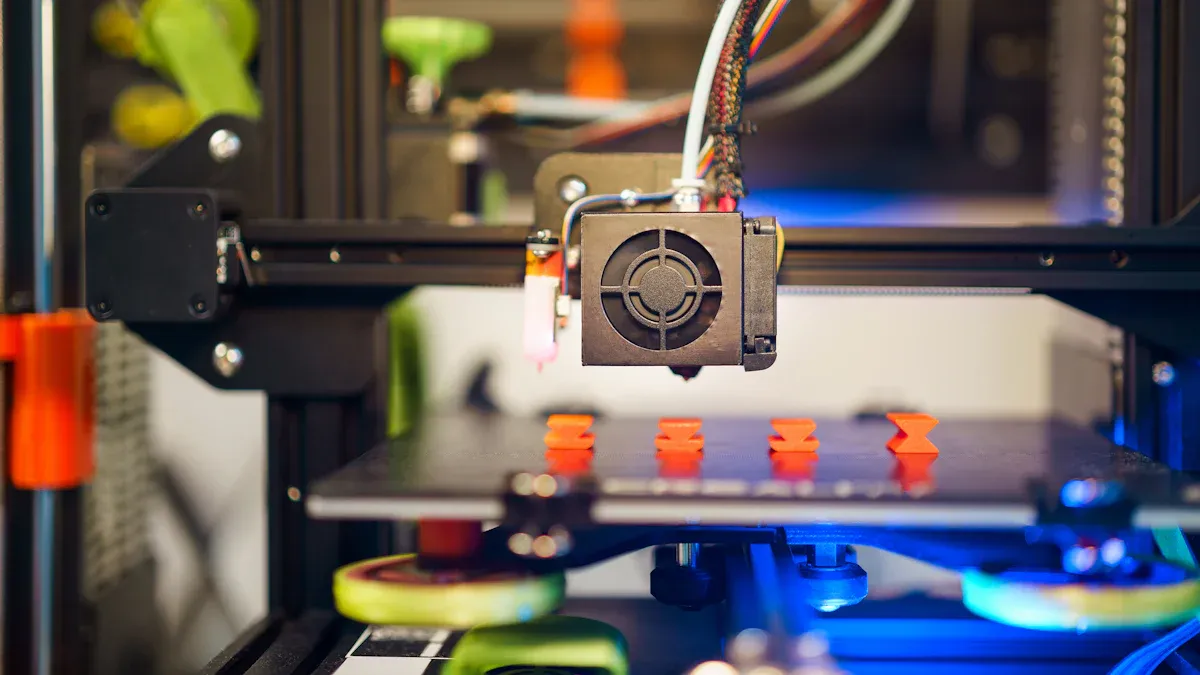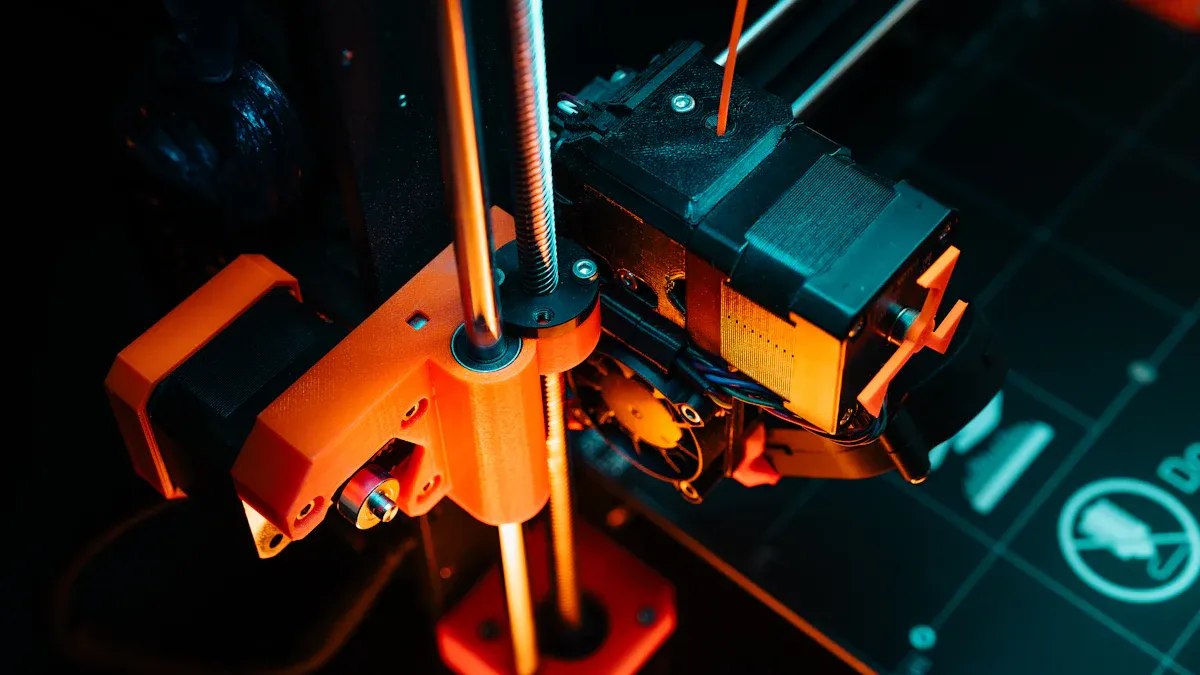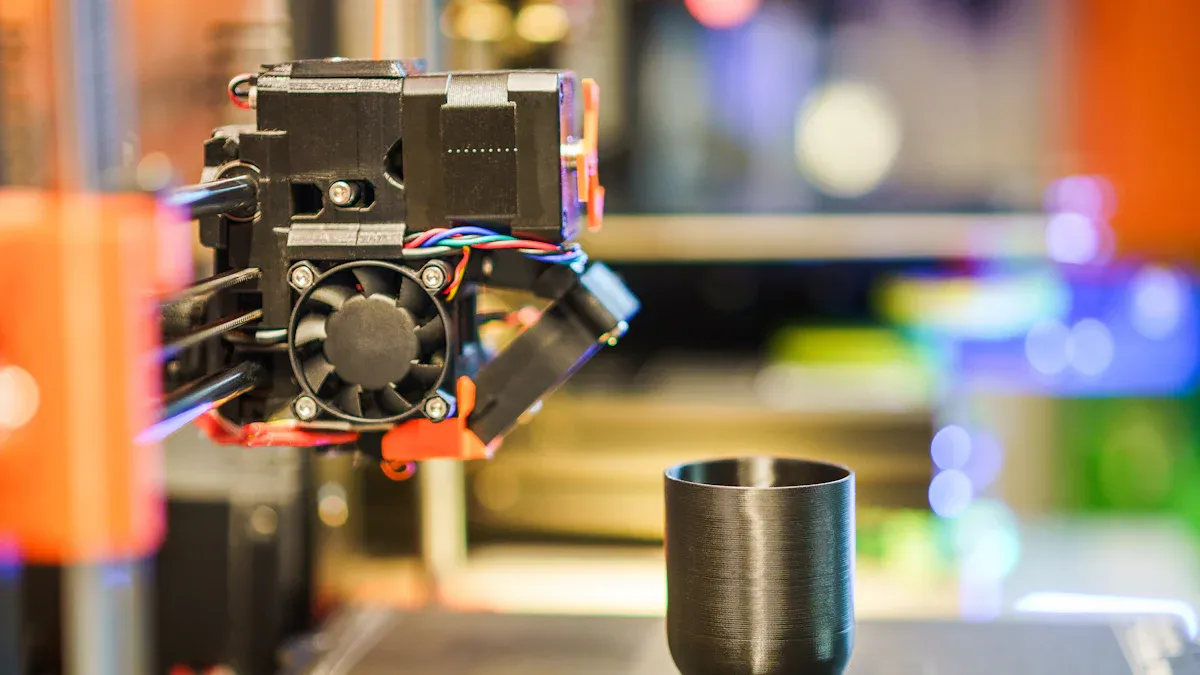Ethan
“As your dedicated Client Manager at Zhejiang Jinteng Machinery Manufacturing Co., Ltd., I leverage our 27-year legacy in precision screw and barrel manufacturing to deliver engineered solutions for your plastic and rubber machinery needs. Backed by our Zhoushan High-tech Zone facility—equipped with CNC machining centers, computer-controlled nitriding furnaces, and advanced quality monitoring systems—I ensure every component meets exacting standards for durability and performance. Partner with me to transform your production efficiency with components trusted by global industry leaders. Let’s engineer reliability together: jtscrew@zsjtjx.com.”

Single screw barrel systems do not involve the co-rotating or counter-rotating distinction found in twin-screw designs. In 2025, single screw barrels still lead the extrusion market. The table below shows their continued dominance:
| Year | Single Screw Barrel Market Share (%) | Notes |
|---|---|---|
| 2023 | 60 | Largest market share among extruder types |
| 2025 | ~60 or slightly higher | Estimated based on stable growth trends |
Manufacturers choose between options like PVC pipe single screw barrel, single screw barrel for blowing molding, and single plastic screw barrel by considering screw design, barrel material, and sector demands.
Single Screw Barrel: Key Product Classifications

PVC Pipe Single Screw Barrel
PVC pipe single screw barrels play a vital role in the extrusion of pipes for construction, plumbing, and electrical applications. Manufacturers design these barrels with a simple structure, which reduces mechanical failure and makes maintenance straightforward. The use of high-strength alloy steel with nitriding treatment increases hardness and wear resistance. This design ensures consistent melting, mixing, and conveying of PVC compounds. The table below highlights key features:
| Feature | PVC Pipe Single Screw Barrels |
|---|---|
| Design | Simple, reliable structure |
| Maintenance | Easy, less technical expertise needed |
| Operational Costs | Lower, efficient operation |
| Temperature Control | Easier to manage |
| Durability | High-strength alloy steel, nitrided for wear resistance |
| Application Suitability | Ideal for standard PVC pipe extrusion |
These barrels dominate small to medium-scale PVC pipe production due to their reliability and cost-effectiveness.
Single Screw Barrel for Blowing Molding
Single screw barrels for blowing molding support the production of bottles, containers, and other hollow products. Engineers equip these barrels with grooved feed screws and deep flights to enhance resin melting and mixing. A barrier mixing section near the screw end improves polymer blending and ensures uniform melting. High compression ratios help achieve melt homogeneity, which is crucial for bubble stability and film quality. Advanced designs may include sensors for monitoring melt pressure and temperature, ensuring precise process control. The use of heat-treated alloy steel provides durability and wear resistance.
- Grooved feed screws improve resin melting and conveying.
- Integrated cooling systems regulate temperature during extrusion.
- Optional sensors enable real-time process monitoring.
PE Pipe Extruder Single Screw Barrel
PE pipe extruder single screw barrels are engineered for the unique properties of polyethylene. These barrels ensure efficient melting, mixing, and conveying of PE materials. The design supports high throughput and consistent melt quality, meeting the demands of industrial PE pipe production. Manufacturers use material and design variations, such as steel alloys and nitrided steel, to match specific polymer and production needs. Application segmentation includes industries like automotive, home appliances, and general plastics, reflecting the versatility of these barrels.
- Small, medium, and large diameter options suit different production scales.
- Optimized for high-volume industrial processing and consistent output.
Performance and Efficiency in Single Screw Barrel Systems
Mixing and Homogenization Capabilities
Mixing and homogenization play a crucial role in the extrusion process. The single screw barrel system moves raw material through feeding, melting, and metering zones. The rotating screw, combined with barrel heating, melts the material and pushes it forward. This process compresses and mixes the molten polymer, ensuring a uniform distribution before it exits through the die.
Engineers often add mixing devices to improve performance. Dispersive mixers, such as Egan and Maddock types, break down clumps and enhance melt quality by applying shear. Distributive mixers, like Saxton or pin mixers, divide and redistribute the melt, which helps achieve even color and additive distribution. Barrier screws separate solid and molten phases, allowing for complete melting before mixing. These design choices depend on the material and the desired product quality.
Tip: Proper mixer selection and screw geometry can significantly improve homogenization, especially for materials with colorants or additives.
However, the single channel flow path in single screw barrels can limit mixing. Polymer velocity varies across the channel, which may cause incomplete turnover. To address this, engineers use additional flights and mixing sections, though these can increase flow resistance and melt temperature. Optimized screw designs help overcome these challenges, delivering high-quality, consistent output.
Throughput and Output Rates
Throughput measures how much material the extruder processes over time. In 2025, a typical single screw barrel with a 100 mm diameter achieves around 150 kg/hr. Optimized screw designs can boost this rate by 18% to 36%. The following table summarizes key throughput parameters:
| Parameter | Details / Values |
|---|---|
| Screw Diameter | 100 mm |
| Typical Throughput | 150 kg/hr |
| Metering-Channel Depth | 4 mm to 8 mm |
| Rate Increase by Screw Optimization | 18% to 36% |
| Maximum Discharge Temperature | ~230°C |
| Limiting Factors | Cooling, extrudate temperature |
Deeper channel depths in the screw reduce shear rates and discharge temperatures, which allows for higher throughput. However, downstream cooling and temperature limits often cap the maximum output. Screw geometry, such as pitch and groove width, also influences the extrusion rate and plasticization quality.
Energy Consumption and Process Stability
Single screw extruders stand out for their energy efficiency in straightforward extrusion tasks. Their simple design and direct mechanical energy transfer result in a lower energy footprint compared to more complex systems. For homogeneous materials, they consume less power and operate with lower costs.
Several factors influence energy consumption:
- Motor efficiency and screw design affect power use.
- Heating and cooling systems play a role in maintaining optimal temperatures.
- Process parameters, such as screw speed and barrel temperature, impact overall efficiency.
Process stability ensures consistent product quality during continuous operation. The length-to-diameter ratio, compression ratio, and screw profile all affect melting and mixing. Material selection for the screw and barrel influences durability and compatibility with different plastics. Operators monitor temperature and pressure using sensors to detect and control fluctuations. Advanced control systems, such as fuzzy logic controllers, help maintain stable conditions and improve melt quality.
Note: Stable process conditions prevent variations in product properties and reduce waste, making process monitoring and control essential for reliable production.
Application Suitability of Single Screw Barrel Designs
Material Compatibility and Processing Needs
Material compatibility stands as a primary factor when selecting a single screw barrel for extrusion. Manufacturers choose barrel materials and treatments based on the type of plastic and the specific processing environment. The following materials are commonly used:
- 38CrMoAIA and SKD61 provide strong wear and corrosion resistance for general plastics.
- Bimetallic alloys offer enhanced durability, especially for abrasive or recycled plastics.
- Custom screw and barrel designs match the requirements of different machines and materials.
These materials address several processing needs, such as wear resistance, corrosion resistance, and maintaining high production efficiency. High-wear-resistance barrels become essential when processing filled or recycled plastics. Corrosion-resistant options protect against aggressive additives or polymers. The table below summarizes how different barrel materials meet various processing demands:
| Material Type | Treatment/Coating | Processing Needs Addressed | Compatible Plastics |
|---|---|---|---|
| SCM-4 High-Hardness Alloy Steel | High-Frequency Quenching/Hard Chrome | Wear resistance, corrosion resistance, withstand shear and heat | PE, PP, PVC, ABS, etc. |
| SACM-1 Alloy Steel | Nitriding Treatment | Improved wear and corrosion resistance | PE, PP, PVC, ABS, etc. |
| SCM-4 Bimetallic Alloy | Hardened surface layer (0.8-1.2mm) | Enhanced wear and corrosion resistance | Various plastics including recycled and filled plastics |
Engineers also consider the thermal expansion of corrosion-resistant materials. They carefully match the screw and barrel to prevent binding or damage during operation. Advanced coatings, such as Colmonoy or tungsten alloys, protect against abrasive wear and extend service life. These choices ensure the single screw barrel maintains optimal performance across a wide range of plastics and processing conditions.
Product Quality and Consistency
The design of the single screw barrel directly influences the quality and consistency of extruded products. A well-designed barrel ensures efficient melting, thorough mixing, and stable conveying of the polymer. This process reduces defects and maintains uniformity in the final product. Key design elements include:
- The length-to-diameter (L/D) ratio controls residence time and thermal management.
- Compression ratio and screw geometry determine mixing intensity and melt homogeneity.
- Barrel metallurgy, such as bimetallic or nitrided surfaces, enhances wear resistance and stabilizes production quality.
Efficient melting and mixing prevent inconsistencies, such as color streaking or dimensional errors. Screw geometry helps regulate temperature, avoiding degradation or over-melting. Proper pressure and flow control maintain consistent material flow, which is vital for uniform product shape and dimensions. Custom screw profiles, like barrier screws or mixing elements, improve melt uniformity and color dispersion. Regular maintenance and tuning of the screw and barrel help sustain high product quality over time.
Tip: Matching screw design to the specific plastic type ensures optimal product quality and reduces the risk of defects.
Industry-Specific Requirements
Different industries require unique features from their extrusion equipment. The single screw barrel must meet these specific demands to ensure reliable and efficient production. The table below outlines key requirements for major application areas:
| Industry/Application | Key Requirements and Considerations |
|---|---|
| Plastic Extrusion | Match screw barrel design to material type (virgin, recycled, filled, blended polymers); L/D ratio typically 24:1 to 36:1; Compression ratio and mixing zones tailored to process; Surface treatments like nitriding or bimetallic coatings for wear resistance; High-wear applications require bimetallic barrels for durability |
| Food Extrusion | Minimal screw-barrel gap to maintain hygiene and prevent contamination; Low shear gaps for heat-sensitive products |
| Rubber and Chemical Extrusion | Reinforced, wear-resistant coatings to handle abrasive filled rubbers; Sometimes wider gaps to reduce shear forces |
Plastic extrusion often requires tight screw-barrel tolerances and specialized coatings to handle a variety of polymers, including those with fillers or recycled content. Food extrusion places a premium on hygiene, demanding minimal gaps and low-shear designs to protect sensitive products. Rubber and chemical extrusion benefit from reinforced coatings and, in some cases, wider gaps to manage abrasive materials and reduce wear.
Proper alignment, maintenance, and temperature control further influence barrel selection across all industries. Efficient melting, mixing, and conveying remain critical for maintaining product quality and stable production lines.
Cost and Maintenance Considerations for Single Screw Barrel
Initial Investment and Equipment Longevity
The initial investment for a single screw barrel system in 2025 remains accessible for most manufacturers. Costs typically range from $10,000 to $50,000, which is much lower than the price of twin screw systems. The table below shows the main factors that influence these costs:
| Factor | Impact on Cost |
|---|---|
| Material Quality | Higher grade = higher cost |
| Automation Level | More automation = higher cost |
| Customization | Special designs = higher cost |
| Supplier Reputation | Well-known = higher cost |
Single screw feed barrels use simple technology and design, which keeps the initial investment and maintenance needs low. This simplicity also helps reduce the risk of mechanical failure. Equipment longevity depends on material selection, screw design, and regular maintenance. Advanced coatings and bimetallic barrels can extend service life, especially when processing abrasive materials.
Operating Costs and Energy Use
Operating costs for single screw barrel systems stay predictable due to stable energy consumption. Most energy use comes from heating the barrel and running the screw motor, which usually requires between 3 and 50 kW. The screw motor itself uses 7 to 15 kW. Because the energy demand remains steady, manufacturers can budget more easily and keep production costs under control. The mechanical work of the screw also generates internal heat, which reduces the need for extra heating and improves energy efficiency. Using energy-saving technologies like variable frequency drives and monitoring systems can further lower costs.
Tip: Stable energy use in extrusion leads to less scrap and better material efficiency compared to other molding processes.
Maintenance and Wear Factors
Maintenance for single screw barrels focuses on managing wear and keeping the system running smoothly. Common challenges include inconsistent melt quality, rapid wear from abrasive materials, and throughput inefficiencies. Wear factors such as abrasive fillers, corrosive additives, and high temperatures can speed up the need for repairs. High-wear zones, like the feeding and discharge areas, require regular inspection. Using advanced materials and coatings helps extend service life and reduce maintenance frequency. Preventive maintenance programs, regular cleaning, and monitoring wear trends allow manufacturers to plan repairs and avoid unexpected downtime.
Future Trends and Innovations in Single Screw Barrel Technology

Technological Advancements in 2025
Manufacturers continue to introduce new technologies that improve the efficiency and performance of extrusion systems. Several innovations stand out in 2025:
- Improved material flow reduces blockages and downtime, which increases production time.
- Optimized heat transfer maintains ideal processing temperatures, enhancing material properties and product consistency.
- Increased durability from high-quality materials leads to fewer repairs and replacements, saving time and costs.
- Customizable configurations allow adaptation to specific production needs, further boosting efficiency.
The Helibar design in next-generation extruders delivers higher throughput and better melt-pressure buildup. This design also lowers melt temperatures and improves melt homogeneity. Reduced barrel wear and shorter residence time help maintain product quality. Many factories now use predictive maintenance and advanced control systems as part of smart manufacturing. These systems monitor equipment health and process parameters in real time, which helps prevent unexpected downtime and ensures stable operation.
Market Demands and Sustainability
Market trends in 2025 reflect rapid changes in the plastics industry and growing environmental awareness. Several factors drive demand for advanced extrusion equipment:
- The plastics industry grows quickly, especially in Asia-Pacific, due to urbanization and consumer needs.
- Lightweight materials see increased use in automotive and aerospace sectors.
- Technological innovations, such as barrier screws and CAD/CAM customization, improve efficiency and reduce energy use.
- Stricter environmental regulations push manufacturers to adopt energy-efficient and waste-minimizing machinery.
- The packaging industry expands, focusing on flexible, biodegradable, and recyclable materials.
- Industry 4.0 and smart manufacturing enable real-time monitoring and operational efficiency.
- Mergers and acquisitions help companies enhance technological capabilities.
Sustainability concerns shape the development of extrusion technology. Manufacturers adopt recyclable materials and reduce machining waste. Many use recycled alloys and water-based cleaning systems to support circular economy goals. Renewable energy sources and energy-efficient equipment help reduce carbon emissions. Advanced coatings and precision engineering lower material sticking and energy use, which decreases the environmental footprint. These practices help companies meet stricter environmental standards and improve their reputation in the market.
Environmental regulations in regions like France and the European Union require strict emission and recycling standards. Manufacturers must innovate to comply with these rules while maintaining cost-effectiveness. This regulatory pressure leads to more sustainable solutions and ongoing investment in research and development.
The co-rotating versus counter-rotating debate does not apply to these systems. Manufacturers prefer them in 2025 for their efficiency, reliability, and adaptability. When choosing, they should match barrel design to material needs, consider wear resistance, and look for features that support digital monitoring and sustainable production.
FAQ
What is the main advantage of a single screw barrel in extrusion?
Single screw barrels offer reliable performance, easy maintenance, and cost efficiency. They suit most standard extrusion applications in 2025.
How often should manufacturers inspect single screw barrels?
Manufacturers should inspect single screw barrels every three to six months. Regular checks help prevent wear and maintain consistent product quality.
Can a single screw barrel process recycled plastics?
Yes, single screw barrels can process recycled plastics. Using bimetallic barrels or special coatings improves wear resistance and extends equipment life.
Post time: Jul-10-2025
